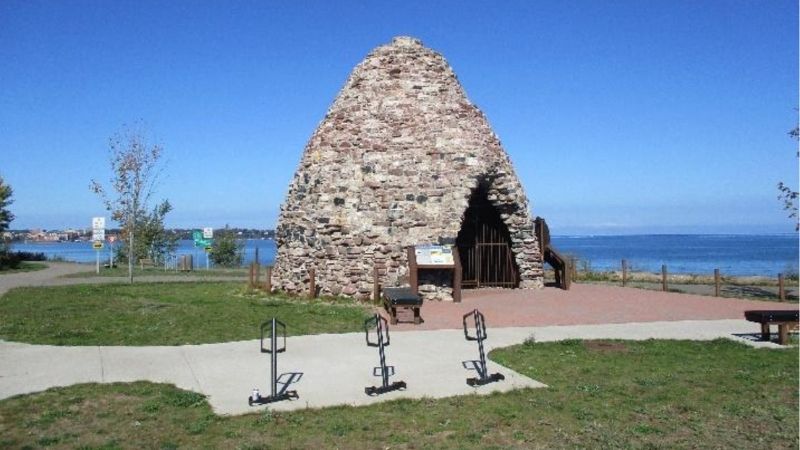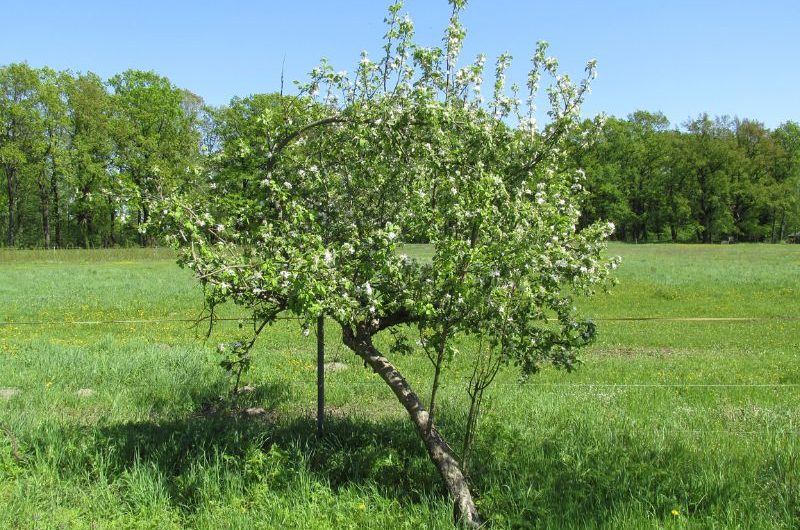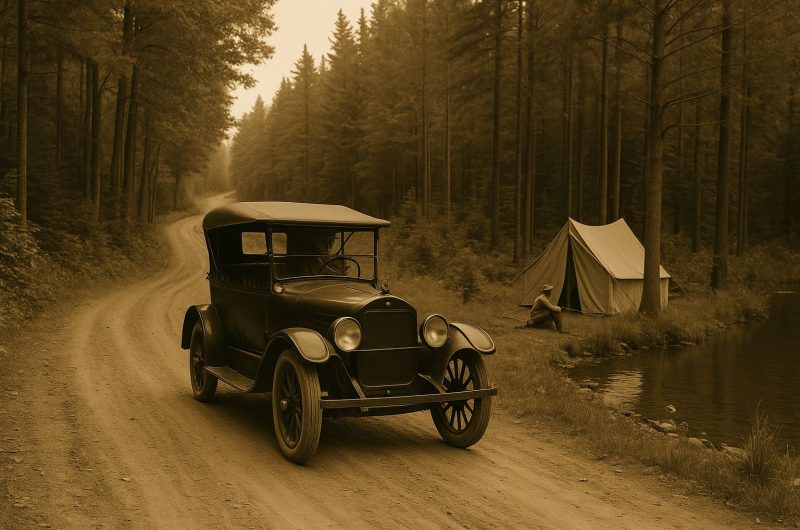Ghosts of a Vanished Upper Peninsula Industry

Charcoal kilns are one of the most interesting treasures of rural UP history, remnants of one of its important early industries. There are two prominent restored charcoal kilns in the UP, but how many authentic kilns still exist? Two recent articles answer that question and include photographs of remaining charcoal kilns.
Visitors arriving in Marquette on U.S. 41 from the south are greeted by a large, restored charcoal kiln. From 1874 to 1907, dozens of charcoal kilns operated along that route, very close to the restored kiln, well before the U.S. Highway, and were even touted as a prime tourist attraction.
These charcoal kilns provided fuel to the nearby Carp River iron furnace. Most of the kilns were destroyed in the 1930s when the highway was rerouted. In the summer of 1970, the second-to-last of the still-existing kilns collapsed, and finally, in early 2019 the final kiln also collapsed.
A weathered sign still sits along the highway in front of the Marquette Area Wastewater Treatment Plant describing the long-gone charcoal kilns.
As often happens with lost relics, laments were common once it was too late to save the kiln. The loss struck a nerve in Marquette, and pleas went out to “resurrect our beloved, historic and now-collapsed beehive kiln that stood in Marquette for over 130 years,” and a project was started to “save a piece of Marquette Iron Range’s iconic past.”
That effort produced the restored kiln that replaced the collapsed one.
On the Lake Michigan side of the Upper Peninsula is a second restored kiln at Fayette Historic State Park.
Like Marquette, there were early pleas to preserve the Fayette Furnace charcoal kilns as historical artifacts of an important regional industry and possible tourist attraction, and like Marquette, the kilns crumbled into ruins before the need for preservation was heeded.
There is a regular pattern that disassembles weathered charcoal kilns: they first lose their tops, and efforts to repair them from that point commonly fail.
Charcoal kilns are relics of one of the Upper Peninsula’s most important industries, the charcoal iron industry. The Western Historical Company’s 1883 History of the Upper Peninsula of Michigan described its “great industries,” with lumbering and iron being two of the major ones. Both were tied to its timber resources.
The history summaries iron’s connection to timber: “The greater part of the [iron] ore mined in the Upper Peninsula is shipped in its natural condition, and reduced into iron by the coke and anthracite furnaces of other States. The furnaces of Michigan use charcoal and produce a superior quality of pig metal. They are located near large tracts of hardwood, and depend for their prosperity upon the abundance of that supply of fuel.”
The charcoal kilns were often located adjacent to major highways (actually adjacent to railways that often were adjacent to major highways) and tourists noticed them, calling them Paul Bunyan’s Beehives due to their shape and function.
Starting in the 1930s, newspapers published histories of the kilns with pleas to save them: “Preserve Those Old Furnace Kilns,” “Old Kilns Are Relics of Charcoal Industry,” “Charcoal Burners’ Kilns Are Peninsula Attraction,” and “Mud Shanties Needed to Preserve Charcoal Kilns.” The pleas were ignored and only those two restored “beehives” remain for the tourists.
Charcoal burning (or production) was an industry to itself, serving as a complementary industry to the iron smelting industry. There were large companies with dozens of kilns. One of the most prominent “players” was Charles H. Schaffer, the Alger County “Charcoal King,” The charcoal production process, the industry structure and its relation to the iron furnaces, and charcoal kilns were discussed in a 2020 article in the journal Upper Country.
That 2020 article left a pregnant question. How many of the charcoal kilns still exist? What condition are they in? Can any of the remnants still be seen?
A 1978 inventory of the Upper Peninsula’s engineering and industrial sites included most of the best-preserved iron furnace charcoal kiln sites. A second related article in the 2021 Upper Country gives more history of these charcoal kilns and includes detailed descriptions of those inventoried kilns, along with photographs of their condition conditions.
A few of the original charcoal kilns still remain “hidden” in the Upper Peninsula as ghosts of a vanished industry.
DOWNLOAD PUBLICATIONS
2020 Upper Country https://commons.nmu.edu/upper_country/vol8/iss1/3/
2021 Upper Country https://commons.nmu.edu/upper_country/vol9/iss1/2/








Interesting … and later we had the birth of Kingsford charcoal briquettes at the Ford plant in Kingsford … different use of charcoal but still interesting. Thank you.
i GREW UP IN CHATHAM, MICHIGAN, HAVING LIVED IN wAUWATOSA, WISCONSIN FOR OVER 50 YEARS. i AM NOW 83 YEARS OLD. SURPRISED TO SEE BIG ARTICLE IN MILWAUKEE jOURNAL sENTINEL LAST APRIL ABOUT THE ICE CAVES IN EBEN, WHICH WE KNEW OF IN THE EARLY DAYS. THE REASON FOR MY MESSAGE:IS BECAUSE MY FATHER WAS AN AVID OUTDOORSMAN , WENT INTO WOODED AREAS THAT NO ONE ELSE HAD. DURING THE 1960’S HE TOLD ME ONE DAY THAT HE WONDERED IF THERE WERE UNDISCOVERED INDIAN MOUNDS NEAR RAPID RIVER. IF HE WAS IN THAT AREA EARLY IN THE SPRING, WHEN HE LOOKED AT THE HORIZON, HE COULD SEE A SERIES OF SMALL HILLS THAT DID NOT MATCH THE WAY THAT THE LOCAL TERRAIN APPEARED.. HE ONCE BROUGHT ME TO THE SITE OF HIS GRANDPARENTS” HOME SITE AFTER THEY CAME TO AMERICA FROM FINLAND, WHICH WAS NORTH OF EBEN. WE DROVE QUITE A DISTANCE THROUGH OLD FIELDS, AND FOUND THE PLACE. THERE WAS A WOODED AREA NEARBY, AND THERE WAS AN AREA THAT HAD BIG BOULDERS BLOCKING A PATHWAY AND LARGE FENCES AND SIGNS OF N O TRESPASSING. WE WONDERED WHAT KIND OF OPERATION WAS GOING ON THERE. THERE WERE NO PEOPLE LIVING FOR MILES. DO YOU KNOW ABOUT THIS INSTALLATION? WE WONDERED IF THEY WERE TESTING STEALTH BOMBERS FROM THE AIR FORCE BASE OR IF SOMEONE WAS GROWING MARIJUANA..
yOU HAVE HEARD OF THE SHACKLETON EXPEDITION TO ANTARCTICA WHERE THE MEN WERE STRANDED…..THE ONLY AMERICAN NAMED BLAKEWELL HAD WORKED IN SENEY & GRAND MARAIS AS A LUMBERJACK AS A YOUNG MAN WHO LEFT HOME IN ILLINOIS WHEN HE WAS ONLY 11ABD WABDERED AKK IVER TGE WIRKD, WE SAW A MUSICAL THIS SPRING AND THERE WAS NEWS THAT THE SHIPWRECK WAS DUSCIVERED NOT LONG AGO. HE CAME BACK TO THE U.P. , MARRIED A FINNISH GIRL FROM RUMELY, AND THEIR DESCENDANTS CAME TO SAME SCHOOL i WENT TO:: EBEN HIGH SCHOOL . THEIR LAST NAME WAS RAJALA.
I HAVE A 97-YEAR OLD UNCLE, TOIVO LUOMA, WHOSE MIND IS AS SHARP AS A TACK, IF ANYONE HAS QUESTIONS ABOUT PAST HISTORY.. HE HAS MANY TALES AND JOKES GALORE. HE LIVES IN MARQUETTE NOW. MARRIED A GIRL FROM MUNISING, AND THEY LIVED IN U.P. ALL THESE YEARS.
MY HUSBAND & I ARE MEMBERS OF THE WISCONSIN GEOLOGICAL SOCIETY, AND HE IS IN CHARGE OF THEIR NEWSLETTER. WE WOULD BE INTERESTED IN INFO RELATED TO THAT TOPIC..
I believe there is an old kiln still partially standing in the Belgiumtown area of Menominee County.
There are several old charcoal kilns in Menomiee County along Old US 2 & 41 west of Bellefuille Road. I have seen them but have not explored them as I believe they are on private property. Some of them seem to be in somewhat good shape, while several have fallen in. Sadly, trees and bushes are slowly taking over and obscuring them from the road.
Fr. Darryl Pepin
Bark River, MI
My great grandfather was Charles H. Schaffer!
Thank you for your insightful article.
This is all so fascinating to me. I’ve only been a Yooper for 2 years and love all of this folklore. I live on Lake Superior in Marquette between the upper and lower docks and it’s so awesome to hear the stories. I was just looking up the old kilns and came upon this! Thanks for the information everyone! 😊